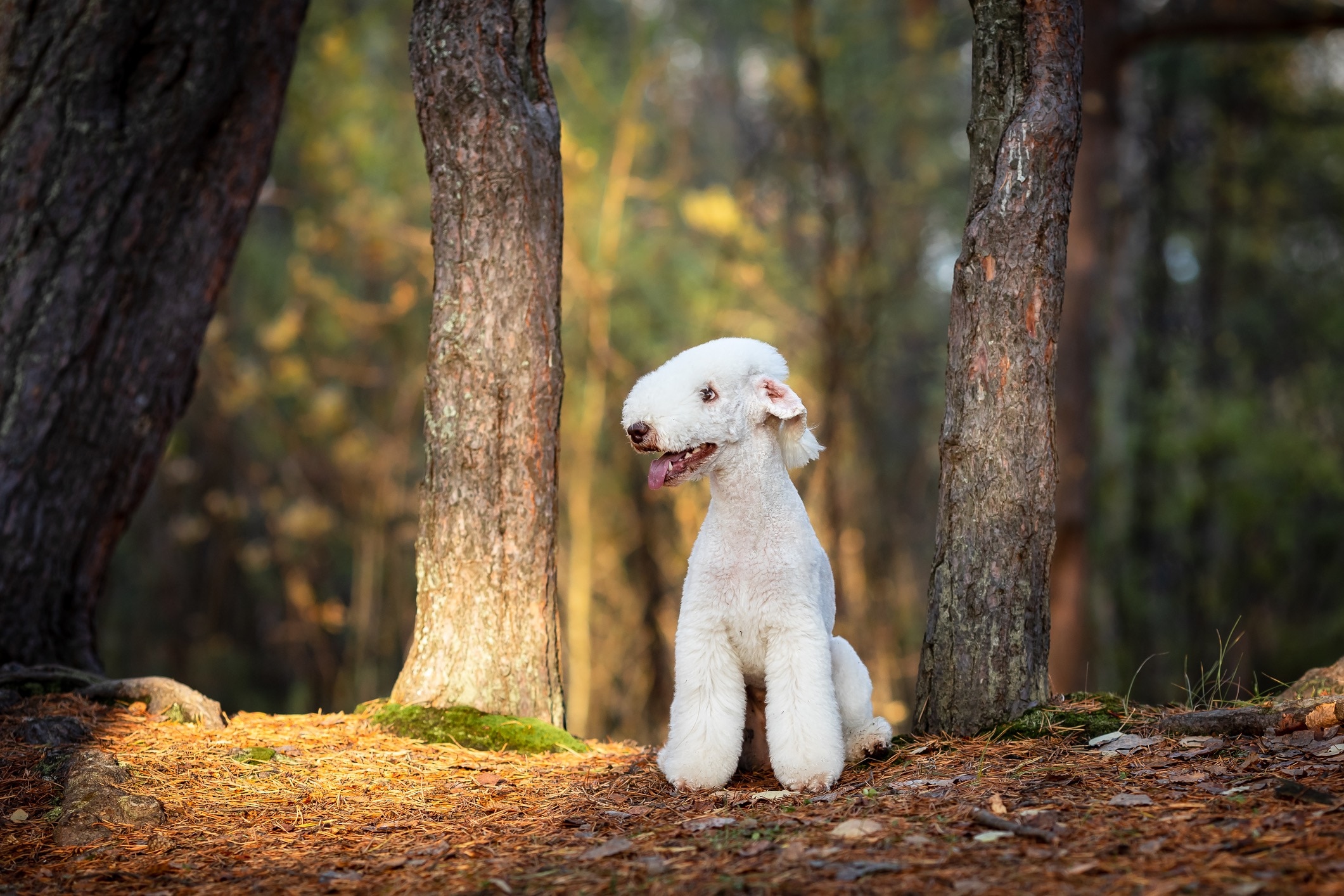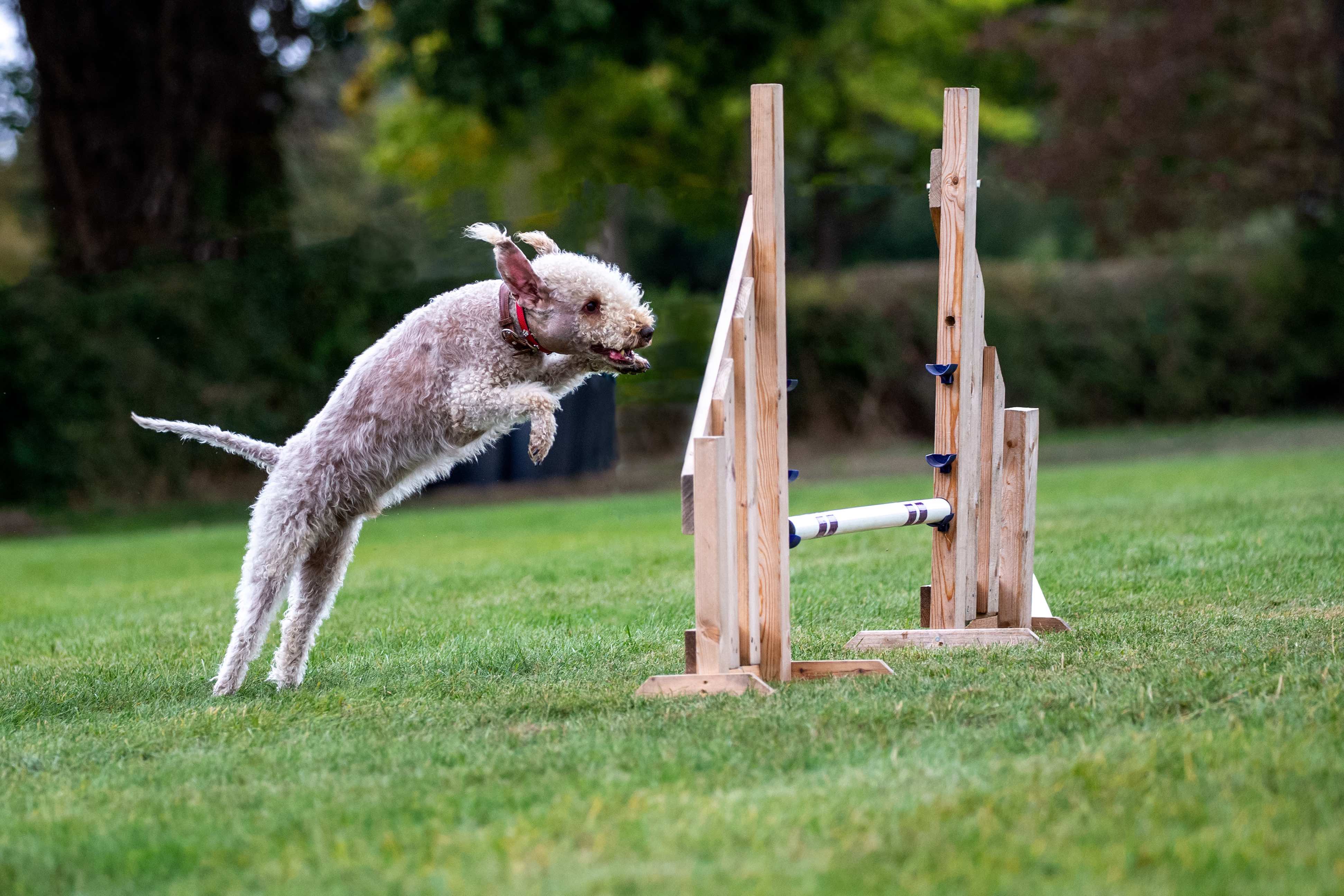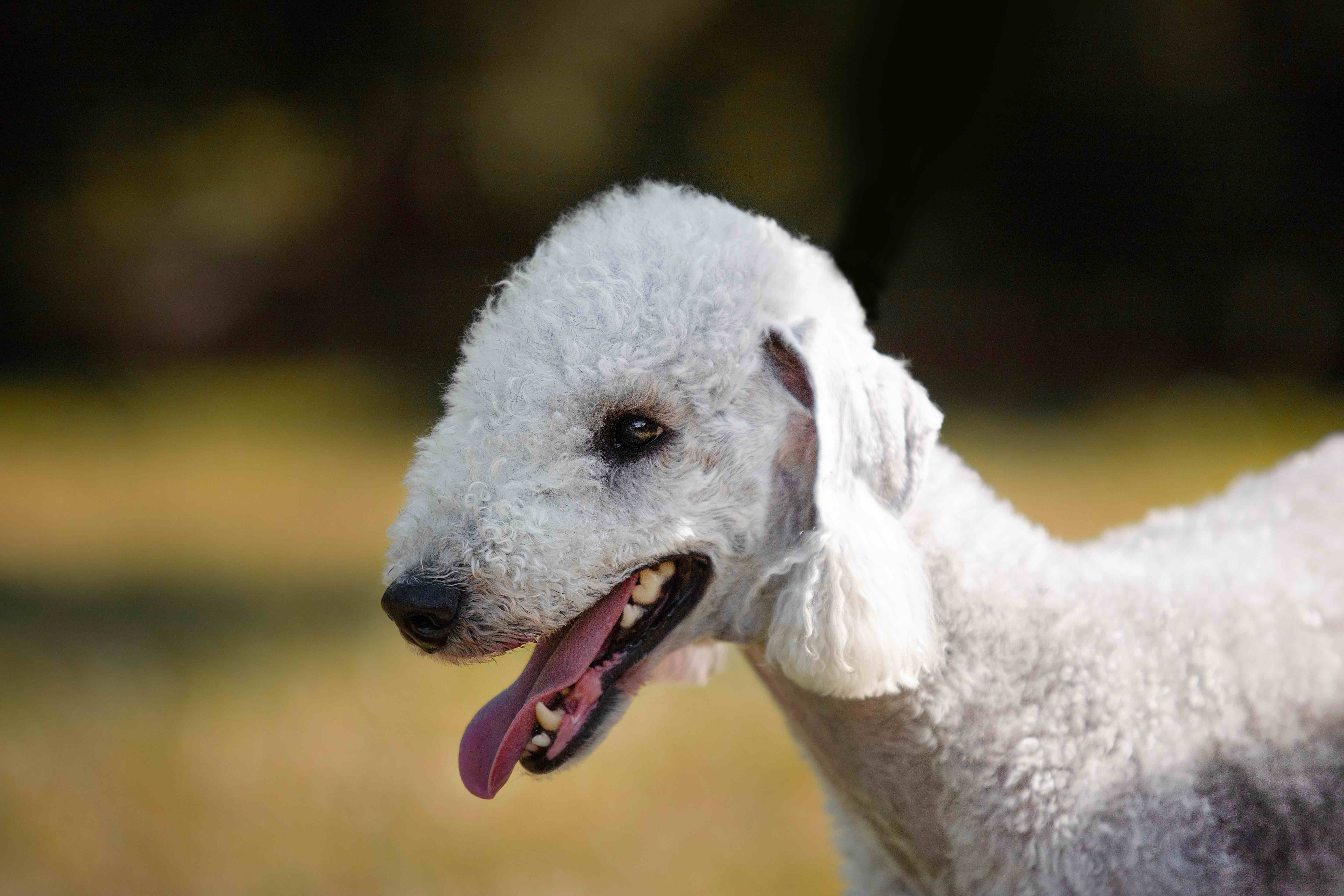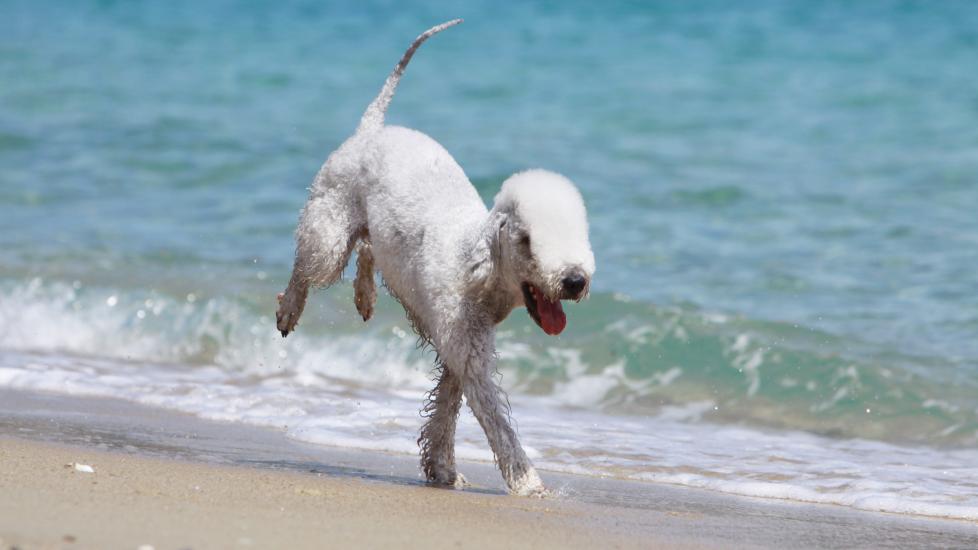Bedlington Terrier
“Is that a lamb?” You might hear this question from time to time if you’re the pet parent of a Bedlington Terrier. This unique and elegant breed is known for their distinctive lamb-like appearance, thanks to their curly fur, arched back, and thin tail.
Originally bred in the mining town of Bedlington in Northumberland, England, these medium-size terriers were initially used for hunting vermin. But, over time, they became popular as companions due to their gentle nature and loyalty.
The breed has a soft and curly coat with a distinctive topknot, a pear-shaped head, a narrow skull, a tapering muzzle, and almond-shaped eyes. When full-grown, the Bedlington Terrier’s size is around 15–17.5 inches and 17–23 pounds.
Caring for a Bedlington Terrier
The Bedlington Terrier’s temperament is charming, loving, and loyal; they’re known for their gentle and affectionate nature. Bedlingtons tend to form strong bonds with their family, but they may be reserved and cautious around strangers. Consistent socialization is important for Bedlington Terrier puppies to grow comfortable around new people.
Though Bedlingtons are calm at home, they are still terriers and were originally bred to work. They have a strong prey drive that might lead them to chase small animals, like rabbits, squirrels, and sometimes cats, so proper training and supervision are essential. Bedlington Terriers are a moderately active breed and enjoy regular exercise, including daily walks and playtime.
Due to their unique appearance and distinctive coat, this breed requires regular grooming from puppyhood to maintain their appearance and prevent matting. A Bedlington’s coat needs to be brushed several times a week and clipped every two months or so, either by a professional groomer or a knowledgeable pet parent.
Bedlington Terrier Health Issues
Bedlington Terriers are generally healthy dogs with an average lifespan of 11–16 years. But, like many breeds, they may be predisposed to a few genetic health issues that potential pet parents should be aware of.
Copper Toxicosis
This is a hereditary condition where excessive copper accumulates in the liver, potentially leading to liver damage. Copper toxicosis is inherited from the parents, and affected Bedlington Terriers must have their copper intake managed (meaning they cannot eat copper-rich dog foods) and, in more severe cases, take medication to help their body eliminate copper.
Signs of copper toxicosis in dogs include:
-
Weakness
-
Increased thirst and urination
-
Weight loss
-
Diarrhea and vomiting that may contain blood
Take your dog to the vet if you notice any of these symptoms.
Patellar Luxation
Patellar luxation is a common condition in dogs where the kneecap dislocates from its normal position. This displacement can cause pain and eventually result in arthritis.
Treatment options for patellar luxation vary depending on the condition’s severity and may involve medication, joint supplements, or surgical intervention.
Eye Problems
Bedlington Terriers are at higher-than-average risk for a number of eye problems that have a genetic basis including:
-
Eye lashes that grow abnormally and can rub on the surface of the eye
-
Persistent pupillary membranes (strands or sheets of abnormal tissue inside the eye)
The Orthopedic Foundation for Animals (OFA) recommends that all Bedlington Terriers be screened for copper toxicosis, patellar luxation, and eye problems prior to breeding. Ask breeders for the results of these tests before purchasing a Bedlington Terrier puppy.
What To Feed a Bedlington Terrier

When choosing dog food, prioritize high-quality, balanced options that consider a Bedlington Terrier’s specific needs and potential health concerns. Reading labels, understanding ingredients, and seeking professional veterinary advice can ensure you provide the best nutrition for your Bedlington Terrier’s overall health and well-being. Here are some tips to help you:
-
Choose dog food with controlled levels of copper if your Bedlington Terrier is at risk for copper toxicosis.
-
Opt for high-quality dog food that contains moderate to high levels of protein.
-
Choose dog food with healthy carbohydrates that are easily digestible, such as brown rice, sweet potatoes, or barley.
How To Feed a Bedlington Terrier
Choose dog food that meets the nutritional standards established by the Association of American Feed Control Officials (AAFCO) and is tailored to your dog’s life stage.
Bedlington Terrier puppies need frequent meals to fuel their growth and meet their high energy demands. Adult dogs generally do well with two meals a day. Senior dogs might find smaller, more frequent meals helpful for digestion and addressing age-related concerns.
Because of the Bedlington Terrier’s distinctive head shape and topknot, select a wide, shallow food bowl to prevent their hairdo from becoming tangled as they eat.
How Much Should You Feed a Bedlington Terrier?
Pet parents can establish a framework for determining proper portion sizes by checking the feeding guidelines on the dog food bag and considering their Bedlington Terrier’s age, activity level, and weight. For more guidance, contact your veterinarian to determine the appropriate feeding amounts based on your Bedlington Terrier’s needs.
Nutritional Tips for Bedlington Terriers
Like any other dog breed, some Bedlington Terriers can benefit from certain supplements to support their overall health. These supplements can include omega-3 fatty acids, joint supplements, copper management supplements, and probiotics.
But if your Bedlington is in good health and regularly eats AAFCO-approved food, additional supplementation should generally not be necessary. Never give your dog a supplement without speaking to your veterinarian first.
Behavior and Training Tips for Bedlington Terriers
Bedlington Terrier Personality and Temperament

The Bedlington Terrier thrives on attention and enjoys an active lifestyle, making them an ideal match for energetic pet parents or families with kids. While they possess bursts of energy and benefit from regular exercise and mental stimulation, Bedlingtons are not excessively high-energy dogs. This curious and intelligent dog is generally easy to train and shows gratitude with affectionate gestures after every adventure.
Bedlington Terriers are suited for families with older children who understand how to interact gently without pulling the dog’s fur or tail. While Bedlingtons may coexist with a cat or another pet if introduced properly and early in life, they have a strong hunting instinct, making small outdoor animals potential targets for chasing.
Bedlington Terrier Behavior
This breed is generally known for their well-mannered and affectionate disposition. According to the Bedlington Terrier Club of America (BTCA), “Bedlingtons are bright, clownish extroverts. They are always anxious to love, please, and be the center of attraction, whether in the show ring or in any room of your house.”
Though Bedlingtons are calm at home, they are still terriers and were originally bred to work.
Bedlington Terriers show a propensity for digging, stemming from their hunting instincts. And while they’re not overly anxious, Bedlingtons can exhibit sensitivity to abrupt changes in their environment.
Bedlington Terrier Training
The temperament of a Bedlington Terrier can significantly impact the training process, which is why understanding their curious nature can help tailor an effective training approach.
Incorporating activities that engage their playful nature and energy level can be highly effective. Positive reinforcement, consistency, patience, and activities that challenge them mentally and physically can result in successful training outcomes for Bedlington Terriers.
Fun Activities for Bedlington Terriers
-
Rally obedience
-
Nose work
-
Digging
-
Fetch
-
Frisbee
-
Long walks
Bedlington Terrier Grooming Guide

Bedlington Terriers can come in a variety of colors. Some of the more recognized coat colors are blue, liver, sandy, and tan. A blue Bedlington Terrier is one of the more popular colors, with a blue-gray appearance. Many Bedlingtons appear white when they are young, but they should develop some color as they get older.
Bedlington Terriers don’t shed a lot and, while there is no such thing as a completely hypoallergenic dog, may be a good fit for pet parents with allergies.
Skin Care
Bedlington Terriers typically don’t need a specific skin care regimen. However, their unique coat will need regular grooming and upkeep to help distribute their natural skin oils and prevent matting.
This breed can benefit from regular baths using a gentle, hypoallergenic moisturizing shampoo or conditioner.
Coat Care
Bedlington Terriers need to be brushed several times a week, if not every day. They benefit from professional grooming every few months to maintain their coat’s shape, trim excess hair, and ensure proper care of areas like the ears, paws, and eyes.
Due to their unique curly coat, Bedlington Terriers can be prone to matting, especially in areas with friction or where moisture accumulates, if they are not groomed regularly.
Eye Care
Bedlington Terriers may develop tear stains. Consistent wiping with a damp cloth around the eyes can help minimize tear stains and ensure cleanliness.
Their distinctive topknot and longer hair around the eyes might obstruct their vision, so trimming the hair around their eyes can help improve their vision as well as prevent irritation caused by long hair getting into their eyes.
Ear Care
Check your Bedlington Terrier’s ears on a regular basis for redness, irritation, discharge, or unpleasant odor. These might signal an ear infection or an underlying concern requiring care. Consistently cleaning your dog’s ears can help prevent infections, especially if an underlying health problem such as allergies puts them at higher-than-average risk.
Considerations for Pet Parents
If you’re considering adding a Bedlington Terrier to your family, make sure you’re prepared to meet their needs. Bedlingtons flourish in an active and affectionate home because they require regular exercise, mental stimulation, dedicated grooming, and lots of love. Positive reinforcement-based training and consistent socialization efforts are essential for their well-being.
Bedlington Terrier FAQs
Is a Bedlington Terrier a good pet?
Bedlington Terriers are affectionate, loyal, and intelligent dogs with a gentle and playful demeanor, making them potentially great family pets—yet prospective pet parents should carefully consider their grooming requirements and the commitment to regular maintenance needed for this breed to thrive.
Are Bedlington Terriers rare?
While not classified as highly rare, Bedlington Terriers are regarded as an uncommon breed. Popularity can fluctuate by region, with some areas having fewer breeders or a smaller population of Bedlingtons compared to more popular dog breeds.
How much is a Bedlington Terrier?
The typical Bedlington Terrier can cost $1,000–$3,000 or more for a puppy from a reputable breeder. Show-quality or dogs from champion bloodlines may be priced higher.
Do Bedlington Terriers bark a lot?
Generally, Bedlington Terriers are not excessive barkers. But, like most dogs, they might bark to alert their family or when reacting to specific stimuli like new people, noises, or unfamiliar situations.
Featured Image: Adobe/Dogs
